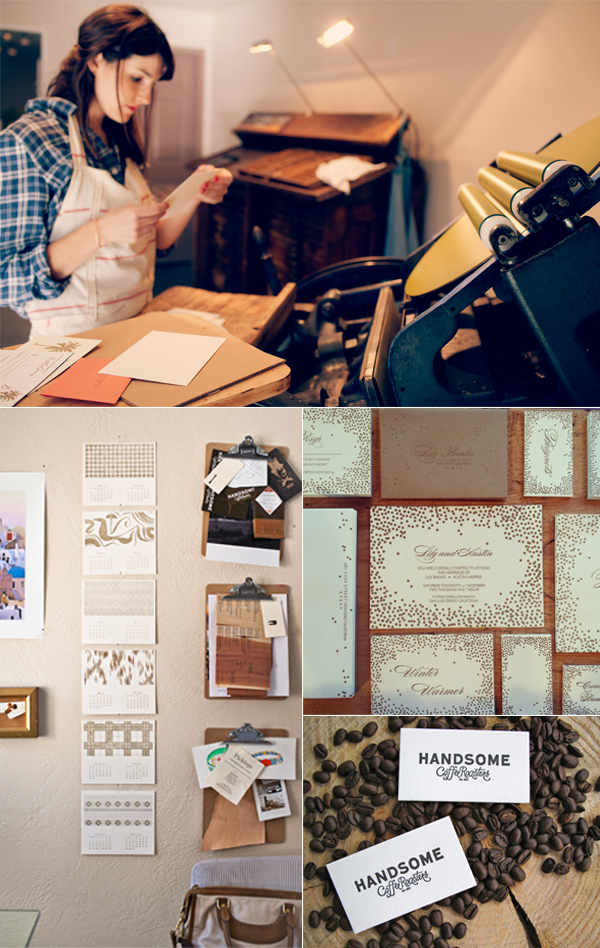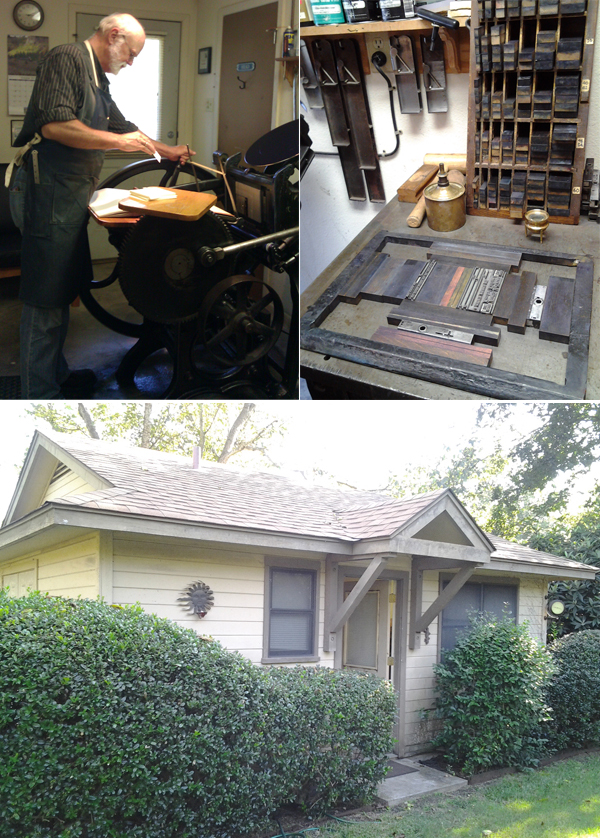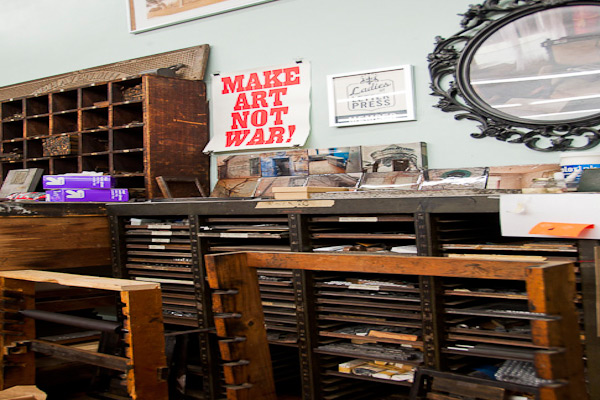The warmth of the South Carolina sun follows us in as we enter Virginia Gregg’s brightly lit printing space, Sideshow Press, located just a stone’s throw away from historic Charleston. Virginia greets us with a smile that lasts from the moment we start the fabulous tour on through the curious conversation threading from her Great Dane, Lulu, organization advice, and of course her gorgeous letterpress work!

THE PRESSES We have 3 presses total: a 12 x 18” C&P, Vandercook No. 4, and a 10 x 15” Heidelberg Windmill
SIZE OF PRINT SHOP 700 square feet
THE LOCATION Located in historic downtown Charleston, our small shop is just around the corner from King Street. You can find us nestled in a small alley off Cannon Street. You can’t miss our bright yellow doors. Our space is crisp and clean, with great natural light…and paper everywhere!
FAVORITE THING ABOUT THE SHOP The sound of presses running [is out favorite thing]. Besides the presses, we have lots of found objects we’ve gathered from our grandmother’s attics, antique stores and travels abroad. They serve as inspiration for designs, techniques or texture. Our ceilings are about 14 ft. high so we never feel cramped or crowded. It’s nice to have that extra air around us filled with natural light. It’s pretty calming and inspiring!
NUMBER OF PRINTERS IN SPACE Just the three of us! And sometimes Lulu, a 130lb Great Dane that comes to hang out every now and then.
MOST VALUABLE SHOP TOOL The line board we use to measure straightness. Can’t live without it!
FAVORITE INK We use VanSon rubber-based inks mostly. Currently we are using a lot of grays since they go with everything. That way the little pops of color really stand out!
SOLVENT OF CHOICE We use odorless mineral spirits for wash ups. On the Vandercook, we’ll run make ready sheets between the roller system to extract as much ink as possible before wash up. And we let the press do some of the work for us by adding wash while its still rolling. When the rollers stop rolling, you can start to clean.
BASE AND PLATE OF CHOICE We switched to the Boxcar base format and photopolymer plating about 3 years ago and haven’t looked back. We found it to be much more accurate, provides better impression quality and the polymer plates are so easy to store, reuse and cut and rearrange as needed. One time we had a funny typo, with the phrase “to the mooon and back”, we’ll that’s an easy fix with a little poly-type surgery and we were back in business.
OIL OF CHOICE Durofilm R&O 150
WHAT TYPE OF RAGS DO YOU CLEAN UP YOUR PRESSES WITH We use the boxed Scott Shop Rags for press wash ups.
FLOORING MATERIAL Our floors are concrete, painted gray. Of course!
FLOOR PLAN TIPS Keep it organized!
PIED TYPE We don’t really have/use much in the way of pied type. We have a little hanging around.
ORGANIZATION ADVICE We use lots of storage boxes and shelves to maximize our small space. Since our ceilings are so tall, we just keep going up instead of out.
PRINTING ADVICE When setting up, make one adjustment at a time. When having a problem, mechanical or while printing, start by looking at the simplest thing first and move up from there.

Big round of thanks to Sideshow Press for giving us a tour of their space today!
 THE PRESSES In general use we have seven presses. There is the C&P treadle press that came from the American Typefounders Company; two C&P Craftsman presses (one for printing and one for scoring and perfing); a Windmill for longer jobs; a Heidlberg KSB; and finally two Vandercooks, a Universal III for poster work, when we get it, and an SP20 that we use almost exclusively for proofing type. In addition to that we have a number of random presses in various states of repair, mostly small format platen presses that no one seems to want these days.
THE PRESSES In general use we have seven presses. There is the C&P treadle press that came from the American Typefounders Company; two C&P Craftsman presses (one for printing and one for scoring and perfing); a Windmill for longer jobs; a Heidlberg KSB; and finally two Vandercooks, a Universal III for poster work, when we get it, and an SP20 that we use almost exclusively for proofing type. In addition to that we have a number of random presses in various states of repair, mostly small format platen presses that no one seems to want these days.














 THE PRESSES: I have four – A 10 x 15 Heidelberg Windmill, a 8 x 12 New Style C&P, a Vandercook 14 proof press and a 3 x 5 Kelsey that I use for demos at shows.
THE PRESSES: I have four – A 10 x 15 Heidelberg Windmill, a 8 x 12 New Style C&P, a Vandercook 14 proof press and a 3 x 5 Kelsey that I use for demos at shows.







 THE PRESSES: I am a bit of a freak for late model Vandercooks. I have two SP-15s, two Universal Is and two Universal IIIs. For smaller work there are a couple of C&P Pilots and a Kwikprint 86 foil stamping press. Because I also recondition presses there are often one or two others in some state of restoration at any given time. The equipment has been chosen very carefully to be safe and suitable for a shared work environment.
THE PRESSES: I am a bit of a freak for late model Vandercooks. I have two SP-15s, two Universal Is and two Universal IIIs. For smaller work there are a couple of C&P Pilots and a Kwikprint 86 foil stamping press. Because I also recondition presses there are often one or two others in some state of restoration at any given time. The equipment has been chosen very carefully to be safe and suitable for a shared work environment.

